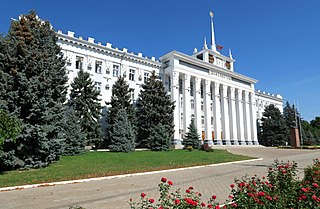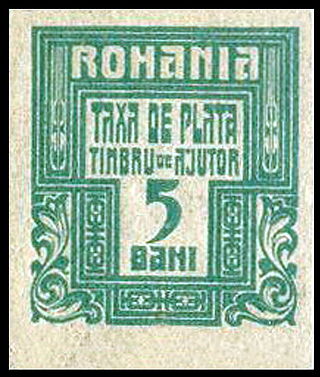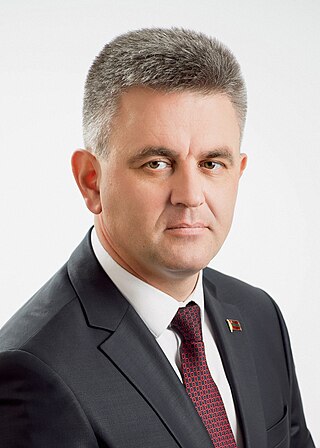
Tiraspol is the capital and largest city of Transnistria, a breakaway state of Moldova, where it is the third largest city. The city is located on the eastern bank of the Dniester River. Tiraspol is a regional hub of culture, economy, tourism, and light industry, such as furniture and electrical goods production.

Transnistria, officially known as the Pridnestrovian Moldavian Republic (PMR), is a breakaway state internationally recognized as part of Moldova. Transnistria controls most of the narrow strip of land between the Dniester river and the Moldova–Ukraine border, as well as some land on the other side of the river's bank. Its capital and largest city is Tiraspol. Transnistria is officially designated by the Republic of Moldova as the Administrative-Territorial Units of the Left Bank of the Dniester or as Stînga Nistrului.

Igor Nikolaevich Smirnov is a Russian-born Transnistrian politician who served as the first president (1991–2011) of the internationally unrecognized Pridnestrovian Moldovan Republic.

The Transnistrian ruble is the currency of the internationally unrecognized state of Transnistria. It is divided into 100 kopecks.
Transnistria is a region in Eastern Europe that is under the effective control of the Russian-backed Pridnestrovian Moldovan Republic but is recognized by the international community as an administrative unit of Moldova, the Administrative-Territorial Units of the Left Bank of the Dniester. The flag of the Pridnestrovian Moldovan Republic is a red-green-red triband, while the Administrative-Territorial Units of the Left Bank of the Dniester use the flag of Moldova.
Transnistria is a region in Eastern Europe that is under the effective control of the self-declared Pridnestrovian Moldavian Republic but is recognized by the international community as an administrative unit of Moldova, the Administrative-Territorial Units of the Left Bank of the Dniester.

The Transnistria conflict is an ongoing frozen conflict between Moldova and the unrecognized state of Transnistria. Its most active phase was the Transnistria War. There have been several attempts to resolve the conflict, although none have been successful. The conflict may be considered as having started on 2 September 1990, when Transnistria made a formal sovereignty declaration from Moldova.
Although most commonly known in English as Transnistria, the official name of the region is Pridnestrovie. Here is a detailed explanation of the names used for Transnistria, both official and unofficial, as they appear in the local languages and in English.

Referendums in Transnistria, according to the Transnistrian Constitution, are one of the lawful forms of expression of people's will.

The following outline is provided as an overview of and topical guide to Transnistria:

The Armed Forces of the Pridnestrovian Moldavian Republic are the military forces of the unrecognized state of Transnistria. The Armed Forces fall under the leadership of the Ministry of Defence. The Armed Forces were created on 6 September 1991 to maintain the sovereignty and independence of the Pridnestrovian Moldavian Republic, in accordance with Article 11 of the Republic's Constitution.

Two universities claim the succession of the Taras Shevchenko State University of Tiraspol; the Transnistrian State University located in Tiraspol, Transnistria, and the Tiraspol State University located in Chișinău, Moldova.

The Ministry of Communications of the Union of Soviet Socialist Republics (USSR) (Russian: Министерство связи СССР) was the central state administration body on communications in the Soviet Union from 1923 to 1991. During its existence it had three names: People's Commissariat for Posts and Telegraphs (1923–32), People's Commissariat for Communications (1932–46) and Ministry of Communications (1946–1991). It had authority over the postal, telegraph and telephone communications as well as public radio, technical means of radio and television broadcasting, and the distribution of periodicals in the country.

People's Commissariat for Posts and Telegraphs of the RSFSR, known shortly as the Narkompochtel, was the central organ of government of the RSFSR that was in charge of the organisation and development of the different forms of communication, including postal service. It was founded in Petrograd on 7 November [O.S. 25 October] 1917 from the Russian Ministry of Posts and Telegraphs and retained its organisational structure.

Nina Viktorovna Shtanski is a Transnistrian former state politician and public figure. She has been the Deputy Prime Minister for the International Cooperation of the Transnistrian Moldovan Republic and the Minister of Foreign Affairs of the Transnistrian Moldovan Republic from 24 January 2012 to 2 September 2015. Ph.D. (2012). She became an honoured foreign service officer Transnistrian Moldovan Republic in 2012. She held the rank of Ambassador Extraordinary and Plenipotentiary.

War tax due stamp is a kind of war tax and postage due stamps that was used for mail when the war tax has not been paid by the sender. They were issued in Romania between 1915 and 1921.
Grigoriy Zakharovich Bronza was a prominent artist of Transnistria. He was an art restorer and an honorary member of the Transnistria Union of Artists. Bronza was a designer of postage stamps of Transnistria and Moldova. He also helped create a number of museums in the former Soviet Union.

Vadim Nikolayevich Krasnoselsky is a Transnistrian politician who is the 3rd and current President of Transnistria. Previously, he served as a member of the Supreme Council of Transnistria from the 7th district, as 6th Speaker of the Supreme Council (2015–2016) and the 7th Minister of the Interior.

The Republic Day of Transnistria also known in the West as Independence Day or National Day is the main state holiday in the partially recognized republic of Transnistria. This date is celebrated annually on September 2.

Romania–Transnistria relations are the bilateral relations between the Pridnestrovian Moldavian Republic, internationally recognized as part of Moldova, and Romania. Romania does not recognize the independence of Transnistria.





















